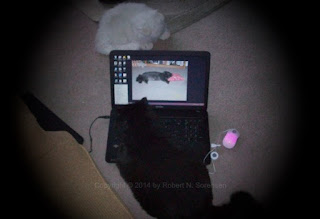Domestic Cat Evolution Story Fails
Those of us who have known our cats and had some with us for years understand that the love exchanged remains long after they are gone. Basement Cat has been gone for over three years but I still get misty-eyed. God has created many gifts for us, whether food or things to discover and use, to better our lives. I fully believe that pets are a part of it.
Believers in chemicals-to-cat evolution tell a tail about gradual domestication and call it evolution. Even though the story seems plausible, there is no evidence of evolution.
 |
| Basement Cat on computer looking at Basement Cat, photo by Robert N. Sorensen |
The second most popular pet worldwide is the cat. Dogs are still number one. The domestic cat (Felis silvestris catus) is so popular a pet species that they are owned by as many as 600 million persons worldwide.Jonathan Losos, the William H. Danforth Distinguished University Professor at Washington University in St. Louis, uses evolution to try to explain why cats are so popular. He does not succeed. The first problem is that, even though he claims to be an evolutionary biologist, he admits that he spent most of his professional career “studying how species adapt to their environment.” In other words, he has spent his career researching the good design of animals and why this design enables them to thrive in their environment.
Don't have a hissy fit, you can read the rest of this very interesting article at "Did Your Pet Cat Evolve?" Another good one is "How We Get Our Fabulous Feline Friends."